- Joined
- Oct 9, 2007
- Messages
- 47,656 (7.43/day)
- Location
- Dublin, Ireland
| System Name | RBMK-1000 |
|---|---|
| Processor | AMD Ryzen 7 5700G |
| Motherboard | Gigabyte B550 AORUS Elite V2 |
| Cooling | DeepCool Gammax L240 V2 |
| Memory | 2x 16GB DDR4-3200 |
| Video Card(s) | Galax RTX 4070 Ti EX |
| Storage | Samsung 990 1TB |
| Display(s) | BenQ 1440p 60 Hz 27-inch |
| Case | Corsair Carbide 100R |
| Audio Device(s) | ASUS SupremeFX S1220A |
| Power Supply | Cooler Master MWE Gold 650W |
| Mouse | ASUS ROG Strix Impact |
| Keyboard | Gamdias Hermes E2 |
| Software | Windows 11 Pro |
Ahead of its launch, tech publication HD Tecnologia posted the press-deck of Intel's 10th generation Core "Comet Lake-S" desktop processor series, as its launch is imminent (30th April, according to the slides). Right upfront, we see Intel's new retail packaging for the flagship Core i9 parts. Gone is the large acrylic dodecahedron, and in its place is a conventional paperboard-looking cuboidal box with a large triangular cutout window (probably made of LDPE) on the front face, which reveals the processor inside.
The next slide reveals all that's new with the 10th generation Core processor family, starting with clock speeds of up to 5.30 GHz, the desktop debut of Intel's Thermal Velocity Boost technology, HyperThreading being enabled across the board (Core i9 thru Core i3), native support for DDR4-2933, new CPU- and memory-overclocking features, and new platform I/O through the 400-series chipset. Next up, we see overclocker-relevant new features. Apparently, these processors allow you to toggle HyperThreading on a per-core basis. Until now, you could toggle HTT only across all cores. Next up, is "overclocking" for the PCI-Express x16 link (PEG) and DMI chipset bus. There are improved V/F curve controls with this generation. Intel is preparing to announce updated XTU and Performance Maximizer utilities. There are some packaging-level refinements, too, such as a physically thinner die (Z-height), making way for a thicker IHS. The internal TIM is still solder. We now move on to the actual SKUs.

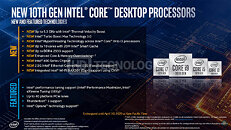


The slides don't reveal which specific SKUs launch on April 30, but we count 22 SKUs spanning every client-segment brand extension by Intel. The lineup is led by the Core i9-10900K, a monolithic 10-core/20-thread processor featuring clock speeds of up to 5.30 GHz boost. Intel claims that the i9-10900K will be the fastest processor for gaming at launch. The Core i7-10700K is an 8-core/16-thread part clocked up to 5.10 GHz (4.70 GHz all-core), which should make it slower than the i9-9900KS, but matching the i9-9900K. The i5-10600K is a 6-core/12-thread clocked up to 4.80 GHz.
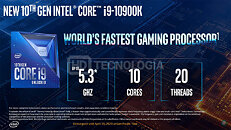
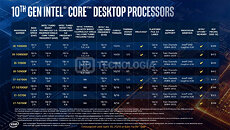
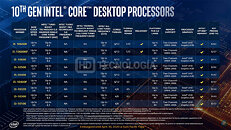
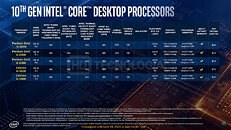
The pricing is particularly interesting. The new 10-core flagship Core i9-10900K launches at roughly the same price as the i9-9900K (launch price). The i7-10700K brings i9-9900K levels of performance at prices resembling those of the i7-9700K at launch (around $280). The i5-10600K brings i7-8700K levels of performance at prices similar to the i5-9600K. There are several SKUs detailed in the slides, the one that has our most attention is the i5-10400F (6-core/12-thread under $160). The prices in the slides could be for 1,000-unit tray quantities, retail prices could differ.
View at TechPowerUp Main Site
The next slide reveals all that's new with the 10th generation Core processor family, starting with clock speeds of up to 5.30 GHz, the desktop debut of Intel's Thermal Velocity Boost technology, HyperThreading being enabled across the board (Core i9 thru Core i3), native support for DDR4-2933, new CPU- and memory-overclocking features, and new platform I/O through the 400-series chipset. Next up, we see overclocker-relevant new features. Apparently, these processors allow you to toggle HyperThreading on a per-core basis. Until now, you could toggle HTT only across all cores. Next up, is "overclocking" for the PCI-Express x16 link (PEG) and DMI chipset bus. There are improved V/F curve controls with this generation. Intel is preparing to announce updated XTU and Performance Maximizer utilities. There are some packaging-level refinements, too, such as a physically thinner die (Z-height), making way for a thicker IHS. The internal TIM is still solder. We now move on to the actual SKUs.




The slides don't reveal which specific SKUs launch on April 30, but we count 22 SKUs spanning every client-segment brand extension by Intel. The lineup is led by the Core i9-10900K, a monolithic 10-core/20-thread processor featuring clock speeds of up to 5.30 GHz boost. Intel claims that the i9-10900K will be the fastest processor for gaming at launch. The Core i7-10700K is an 8-core/16-thread part clocked up to 5.10 GHz (4.70 GHz all-core), which should make it slower than the i9-9900KS, but matching the i9-9900K. The i5-10600K is a 6-core/12-thread clocked up to 4.80 GHz.




The pricing is particularly interesting. The new 10-core flagship Core i9-10900K launches at roughly the same price as the i9-9900K (launch price). The i7-10700K brings i9-9900K levels of performance at prices resembling those of the i7-9700K at launch (around $280). The i5-10600K brings i7-8700K levels of performance at prices similar to the i5-9600K. There are several SKUs detailed in the slides, the one that has our most attention is the i5-10400F (6-core/12-thread under $160). The prices in the slides could be for 1,000-unit tray quantities, retail prices could differ.
View at TechPowerUp Main Site





